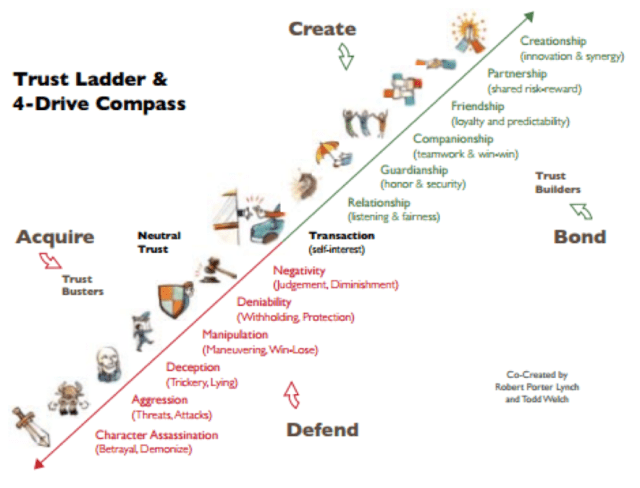Tip 20: Build and Maintain Trust
Johan Rudolph Thorbecke, one of the most influential Dutch politicians of the 19th century, once stated: “Trust comes on foot but leaves on horseback.” It means that while trust takes time and effort to build, it’s quick and easy to break.
Collaborative business relations are, in general, built for the long term. Long-term relationships require a high level of trust among the partners to flourish. Short-term relationships, on the other hand, do not need that level of trust. In a transaction where I buy a bottle of water from a vendor, I only need just that amount of trust for the vendor to hand me the bottle the moment I hand them the money. That is the end of the transaction and, thus, the end of the requirement for continued trust. But in collaborative business relations, we need continuity in trust among the partners. After all, we are pursuing a goal that we cannot easily achieve alone.
How do we build and maintain trust? Again, as the Johan Thorbecke quote suggests, trust is difficult and vulnerable, hard to build and easy to lose. In the article “Leadership and the structure of trust,” first published in the May-June 2011 issue of The European Business Review, authors Paul Lawrence and Robert Porter Lynch discuss the four innate drives that every individual is influenced by:
- The drive to acquire. This drive comes from the basic need to own at least a minimum of essential resources.
- The drive to defend, with its focus on defending yourself and your loved ones.
- The drive to bond, to create long-term relationships.
- The drive to create, to learn and to build.
According to Lawrence and Porter Lynch, every individual has all four drives but in a different balance. They position these drives on the ladder of trust, which has a neutral level and often characterized as a belt. The drives to acquire and defend are the basic levels that need to be fulfilled for every individual. However, if an individual has a very strong drive for acquiring and defending, they might have a focus that is too much on the negative side. They might also display trust-busting behavior. On the other side of the belt are the drives to bond and create. Individuals with strong development on this side show strong trust-building behavior.
Let’s take a look at this figure on the ladder of trust drawn by Lawrence and Porter Lynch containing the four drive compass that was included in their article. There you will recognize behaviors that influence trust building as well as trust-busting activities. Hidden agendas are a recognizable behavior we all have seen before, and it’s harming the level of trust we create. Openness in our relationship and sharing information, on the other hand, helps build trust.

The Lawrence and Porter Lynch article is truly worth the read, and the ladder of trust is a useful tool to help recognize people’s behaviors. The ladder of trust tries to counter other people’s behavior with your own behavior so that you can build and maintain trust.
Nevada Management Professor Bret L. Simmons also has an article and a lecture published in 2013 that’s worth looking into when it comes to establishing trust. He says we have no control over whether or not people trust us. However, we do control how trustworthy we are. At first, people will not look at the question of whether they trust other people, but they will judge us based on the trustworthiness we show. This is a behavior we can fully influence ourselves. When combining this with the drives described by Lawrence and Porter Lynch, we see that working on the drives to bond and create will also increase our trustworthiness.
Trust is hard to build and easy to destroy.
But while we cannot force other people to trust us, we can at least show them that we are worthy of their trust.
I am publishing my ebook “25 tips for successful Partnerships and Alliances” in parts here on my website. Every other week a tip from the book will be shared, in the weeks in between I will publish my regular column. If you prefer to read the tips in the ebook faster rather than wait a full year then click here to purchase your own copy of the book.